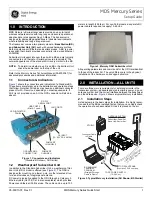
Installation and Connection
page 31
NF 650 - rev. 01 / 29.06.2020
Installation and Connection
20 General Installation Instructions
Ensure that the following instructions regarding “Electrostatic discharge” (ESD) and installation
place are followed during installation.
Â
Ü
Follow applicable legal or operational guidelines.
Improper handling can result in injury and/or damage to the equipment.
20.1 Avoidance of electrostatic discharge (ESD)
ESD risks
Maintenance procedures which do not require power supplied to the instrument shall not be
carried out before the unit has been disconnected from mains power in order to minimise
danger and ESD risks.
Disconnect the NivuFlow from mains power.
The sensitive electronic components inside the unit may get damaged by static electricity.
NIVUS GmbH recommend the following steps to prevent the device from getting damaged due
to electrostatic discharge:
Â
Ü
Discharge static electricity from your body before touching the instrument’s electronic
components.
Â
Ü
Avoid unnecessary movements to reduce the risk of building up static electricity.
20.2 Installation and Mounting versions
The transmitter is available in two different mounting versions:
• Type E0 - for direct DIN rail mounting in control cabinets or similar enclosures
• Type E1 - special DIN rail mounting enclosure without cover stripe, with extended DIN
rail fastening
Installation in NIVUS field enclosure
ZUB0 NFWx
Pre-assembled units with simultaneous order
As soon as NivuFlow 650 Type E1 and the field enclosure are ordered simultaneously the
units are shipped in pre-assembled condition.
CAUTION
NivuFlow 650 Type E0 not suitable for installation in NIVUS field enclosure
It is not possible to install a NivuFlow 650 Type E0 in a NIVUS field enclosure unless the
transmitter is
converted
to a Type E1 unit. The conversion and the modification of connec-
tions can be carried out by NIVUS.
















































